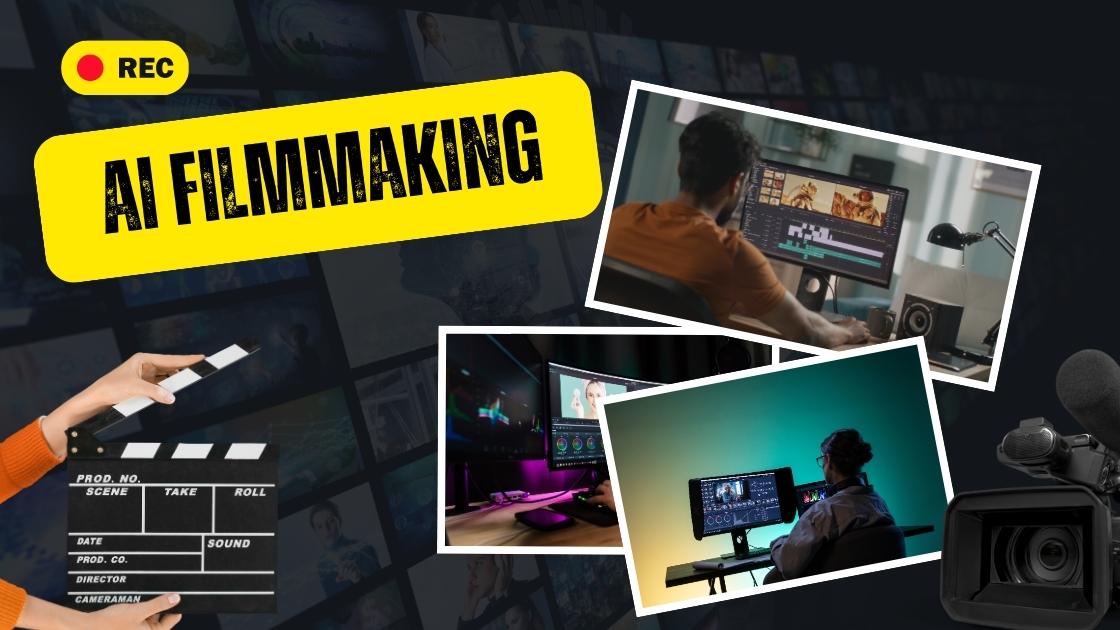Can you imagine a world where making a short film doesn’t require a full crew, weeks of editing, and endless late nights? Welcome to the exciting rise of the best AI filmmaking tools.
These new platforms allow filmmakers and creative professionals to create videos, edit scenes, add cinematic effects, and even generate actors with just a text prompt.
The next wave of storytelling is already here, and it’s powered by generative AI models.
What are AI Filmmaking Tools
AI filmmaking tools are software platforms that use AI-powered technology to transform the production process.
Instead of relying only on traditional editing tools, these new systems allow you to type a text prompt, feed in image references, or bring your own assets, and the AI video generator does the heavy lifting.
Whether it’s creating a cinematic sequence, adding native audio generation, or ensuring consistent characters across multiple scenes, an AI filmmaking tool helps streamline video creation from script to final cut.
In simple terms, AI-powered filmmaking combines creativity with automation. It makes the workflow faster, gives you more creative control, and lets even small teams create high-quality video content that once required Hollywood budgets.
Key Features to Look For in the Best AI Filmmaking Tools
The best AI video generator should create high-quality video output with customizable settings. Look for tools that turn text prompts into visuals, support bringing your own assets, and keep characters consistent across clips.
Native audio generation adds soundtracks and dialogue, while flexible workflows make video creation easier. Many platforms also balance free options with pAId plans, so you can test before upgrading.
Use these Tools to Create, Edit, and Enhance Videos with AI
Today’s AI platform options allow you to:
- Generate a video clip from a text-to-video generator
- Add camera movement to static scenes with AI motion tools
- Produce lip sync dubbing in multiple languages
- Enhance your video editing process with an AI-powered editing tool
- Ensure visual consistency when creating videos using text prompts
This means that both beginners and professional filmmakers now have access to a curated list of AI video tools that can handle everything from scriptwriting to visual effects.
Runway ML
Runway ML has become a go-to ai filmmaking tool for creators who want to mix text prompts, assets, and cinematic visuals. It’s known for pushing generative ai video forward.
Pros and Cons
- Pros: Easy to use for beginners, wide range of ai video editing options
- Cons: Can feel limited on free plan, heavy computing time for complex projects
Pricing
Runway offers a free tier with basic features, while paid plans unlock higher-quality video generation and more exports.
Pika Labs
Pika Labs is popular for turning simple text into short film clips with surprising detail. Many indie filmmakers use it for quick visual ideas.
Pros and Cons
- Pros: Fast video generation, great for experimenting with prompts
- Cons: Outputs can look inconsistent, not ideal for long videos
Pricing
Basic use is free, with paid plans for higher resolution and longer video creation.
Adobe Firefly + Premiere Pro AI
Adobe’s Firefly paired with Premiere Pro AI is designed for creative professionals who need ai-powered filmmaking inside a familiar video editor.
Pros and Cons
- Pros: Seamless integration with Adobe Premiere Pro, powerful editing tool options
- Cons: Subscription can be pricey, not as simple as some standalone ai tools
Pricing
Available through Adobe’s Creative Cloud subscription with different paid plans depending on your bundle.
Synthesia
Synthesia is best known for its ai video generator that creates lifelike avatars delivering scripts in multiple languages.
Pros and Cons
- Pros: Great for presentations and tutorials, supports lip sync and native audio generation
- Cons: Less cinematic, avatars may feel repetitive after heavy use
Pricing
Offers monthly paid plans, with pricing based on video minutes and features.
Descript
Descript lets you edit video as easily as editing text, making it an ai-powered editing tool perfect for podcasts and video content.
Pros and Cons
- Pros: User-friendly, strong transcription and overdub features
- Cons: Not designed for high-end cinematic visuals, internet connection required
Pricing
Free basic plan, with paid plans unlocking advanced ai tools and more video exports.
DeepBrain AI
DeepBrain AI creates ai-powered avatars for training videos, customer service, and educational clips.
Pros and Cons
- Pros: Simple to use, supports multi-language video generation
- Cons: More business-focused than creative filmmaking, limited cinematic effects
Pricing
Paid plans vary depending on usage and features, often tailored for businesses.
Kaiber
Kaiber helps artists and filmmakers turn images and text prompts into stylized ai video outputs with unique visual consistency.
Pros and Cons
- Pros: Strong for music videos and creative projects, customizable styles
- Cons: Output may not suit professional video production, can take long computing time
Pricing
Free trial available, with paid plans for longer and higher-quality video content.
Luma AI
Luma AI specializes in creating realistic 3D scenes and camera movement, making it perfect for cinematic storytelling.
Pros and Cons
- Pros: High-quality video generation, great for 3D environments
- Cons: Still developing features, not as flexible for editing workflows
Pricing
Free access for experimenting, with paid plans coming for advanced creators.
HeyGen AI
HeyGen AI lets you generate ai-powered avatars and short videos using text prompts, ideal for explainer clips.
Pros and Cons
- Pros: Easy to use, supports text-to-video generation
- Cons: Avatars can feel limited, not the best for filmmakers chasing cinematic output
Pricing
Offers free trials, with paid plans for more minutes and advanced features.
Flawless AI
Flawless AI is built for filmmakers needing precise lip sync and dubbing to adapt films for global audiences.
Pros and Cons
- Pros: Excellent lip sync accuracy, great for consistent characters in dubbing
- Cons: Niche use case, not designed for general video generation
Pricing
Enterprise-style paid plans, with costs depending on project size.
Stable Video Diffusion
Stable Video Diffusion is an open-source generative ai video model that turns text prompts into moving visuals.
Pros and Cons
- Pros: Open-source and customizable, strong for experimenting
- Cons: Requires technical knowledge, not beginner-friendly
Pricing
Free as an open-source project, though high-quality video generation requires computing time or paid cloud services.
Gen-2 by Runway
Gen-2 is Runway’s next-level video model that pushes ai video generation further with cinematic outputs.
Pros and Cons
- Pros: Produces realistic short films, supports videos using text prompts
- Cons: Still experimental, requires patience for the best results
Pricing
Free limited use, with paid plans unlocking higher-quality video clips and longer outputs.
Papercup AI
Papercup AI focuses on ai-powered dubbing and translation, making it a favorite for documentaries and global video production.
Pros and Cons
- Pros: Accurate translation with natural voices, great for global reach
- Cons: Less useful for cinematic filmmaking, audio sync can vary
Pricing
Pricing is custom depending on video length and languages needed.
Opus Clip
Opus Clip uses ai video tools to repurpose long-form content into short, engaging clips for social media.
Pros and Cons
- Pros: Saves time, great for content creators and marketers
- Cons: Not designed for cinematic filmmaking, quality depends on input video
Pricing
Free trial available, with paid plans offering more exports and higher resolution.
Magisto
Magisto is an ai-powered video editor that helps turn raw footage into polished stories with minimal effort.
Pros and Cons
- Pros: Simple for beginners, automated video editing with music and effects
- Cons: Limited creative control, less suited for professional filmmakers
Pricing
Freemium model with affordable paid plans for longer and better-quality edits.
Full list of AI Video Alternatives
This list of AI tools represents the best AI tools for 2025. Each AI tool can be seen as a generation tool in its own right, and together they form a list of AI filmmaking solutions that cover every stage of the creative process.
From AI video editing to advanced AI video generation, these platforms are shaping the next decade of video production.
Use Cases of AI in Filmmaking
Filmmakers today are using AI video tools in surprising ways:
- Short film production without large crews
- Video generation for advertising and marketing campAIgns
- Video creation for social media content at scale
- Educational video production with AI-powered avatars
- Documentaries with automated subtitles and lip sync
The flexibility of these AI-powered tools makes them suitable for both indie projects and big studio video content.
Challenges and Limitations of AI Filmmaking Tools
Of course, not everything is perfect. Generative AI has its limits. Computing time can delay renders, some AI video outputs lack full creative control, and even the best AI video generator may struggle with complex camera movement.
There are also questions about copyright, originality, and whether generative AI models will reduce jobs in traditional video editing.
What makes the best AI video generator
The best AI video generator balances quality, speed, and customization. It should offer AI-powered filmmaking features like text-to-video generation, native audio generation, and the ability to keep consistent characters throughout a project.
A good AI video generator is also fully customizable, supports video editing and video creation, and gives filmmakers a clear workflow with minimal learning curve.
More Generative AI video tools
Beyond the top 15, new players are emerging fast. Veo by Google AI pro and google AI ultra have been making headlines.
Veo 3 is positioned as one of the best generative AI video models yet, offering cinematic quality and customizable options for video creation.
PAIred with ltx studio and gemini, these AI-powered platforms are pushing the boundaries of what AI video generation can deliver.
Future of AI in Filmmaking
Looking ahead, the future of AI filmmaking feels both thrilling and a little daunting. Imagine an open-source AI video model that allows anyone to produce a cinematic short film.
Picture video editors that no longer need manual cuts because AI video tools understand natural language text prompts.
Consider a world where ltx studio, google AI pro, gemini, and veo 3 merge to create the best generative AI system for global video production.
The creative process will remAIn in human hands, but AI-powered filmmaking is clearly here to stay. With more customizable AI platforms, smarter generation tools, and high-quality video outputs, we’re moving closer to a future where video generation becomes as simple as writing a script.
Here are some expert suggestions and views about AI in filmmaking:
Christopher Nolan: the danger is abdication of responsibility
Nolan urges accountability, warning that AI can’t become a way for studios to dodge responsibility, even as he acknowledges it’s a powerful tool. Variety interview.
Tyler Perry: pausing expansion after Sora
After seeing text-to-video advances, Perry halted an $800M studio expansion and called for the industry to get ahead of the impact on jobs. The Hollywood Reporter.
Tim Burton: style mimicry feels “very disturbing”
Burton compares AI copies of his look to a robot taking your humanity—capturing a broader fear about identity and authorship. Variety report.
Pixar’s Pete Docter: useful for drudge work, bland for art
Pixar’s creative chief says today’s AI can feel “bland,” unlikely to replace animators, but it may free artists from tedious tasks so they can focus on story and performance. Business Insider recap.
Conclusion
The best AI filmmaking tools are no longer experiments; they are the backbone of modern video production.
From AI video editing to full-scale generative AI video generation, these platforms let creative professionals and beginners alike create videos faster, smarter, and with more visual consistency than ever before.
Whether you’re using runway, ltx studio, adobe premiere pro, or experimenting with google AI ultra and veo 3, the best AI video generator for you is the one that fits your creative workflow.
This list of AI tools is just the beginning. As generative AI evolves, the output will only get more cinematic, more customizable, and more powerful.
The next wave of storytelling belongs to those ready to embrace AI tools for filmmakers and make the most of this revolution in video content creation.

